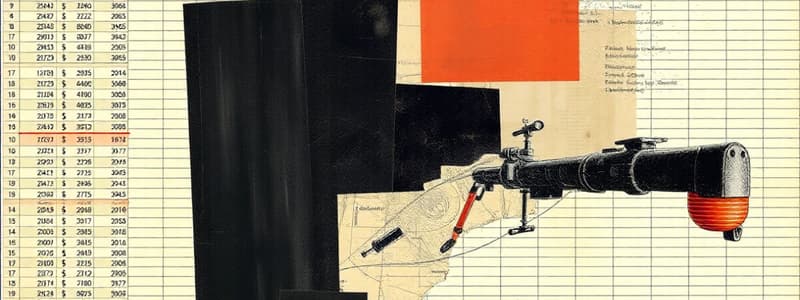Podcast
Questions and Answers
What is a collection of worksheets saved in a single file called?
What is a collection of worksheets saved in a single file called?
- Cell
- Workbook (correct)
- Worksheet
- Formula
What is the intersection of a row and a column in a spreadsheet known as?
What is the intersection of a row and a column in a spreadsheet known as?
- Workbook
- Worksheet
- Cell (correct)
- Cell Reference
What is a grid of cells where you enter data?
What is a grid of cells where you enter data?
- Worksheet (correct)
- Formula
- Workbook
- Cell Reference
Which term describes an expression that performs a calculation?
Which term describes an expression that performs a calculation?
What is a pre-defined formula that performs a specific task?
What is a pre-defined formula that performs a specific task?
The currently selected cell in a spreadsheet is known as what?
The currently selected cell in a spreadsheet is known as what?
What is the address of a cell called?
What is the address of a cell called?
Which of the following allows you to copy the contents of one cell to another?
Which of the following allows you to copy the contents of one cell to another?
When you copy data, where is it temporarily stored?
When you copy data, where is it temporarily stored?
Which action does the fill handle primarily facilitate?
Which action does the fill handle primarily facilitate?
What is the primary function of the clipboard?
What is the primary function of the clipboard?
What is the role of a cell reference?
What is the role of a cell reference?
What is the first step in writing a formula?
What is the first step in writing a formula?
Which of these is a spreadsheet program?
Which of these is a spreadsheet program?
Which best describes the use of worksheets?
Which best describes the use of worksheets?
Flashcards
Workbook
Workbook
A collection of worksheets saved in a single file.
Cell
Cell
The intersection of a row and a column.
Worksheet
Worksheet
A grid of cells where you enter data.
Formula
Formula
Signup and view all the flashcards
Function
Function
Signup and view all the flashcards
Active cell
Active cell
Signup and view all the flashcards
Cell reference
Cell reference
Signup and view all the flashcards
Fill handle
Fill handle
Signup and view all the flashcards
Clipboard
Clipboard
Signup and view all the flashcards
Study Notes
- A workbook represents a comprehensive collection of individual worksheets saved within a single digital file, which can facilitate organization and data management. Workbooks are commonly used in spreadsheet software like Microsoft Excel or Google Sheets and are especially advantageous for users who need to manage, analyze, or present large amounts of data systematically. Each workbook can contain multiple worksheets, enabling users to separate data into different tabs while maintaining a cohesive structure. This feature is particularly useful in professional settings where financial reports, project plans, or statistical analyses are prepared, as it allows for better categorization and access to data within a singular file.
- A cell signifies the precise intersection of a row and a column in a worksheet, acting as the basic unit where data can be inputted, modified, or calculated. Each cell is identified by its unique cell reference—composed of a letter indicating the column and a number indicating the row—allowing users to pinpoint where information is stored. For example, the cell located at the intersection of column A and row 1 is referred to as A1. Cells can hold various types of data, including numerical values, text, boolean values, and even special formats like dates or currencies, which can then be manipulated within the worksheet.
- A worksheet refers to a grid of cells organized into rows and columns, serving as a structured space where users can input a wide array of data types such as text, numbers, and formulas to analyze information effectively. Worksheets are designed to facilitate calculations, data analysis, and reporting, making them integral to tasks like budgeting, grade tracking, or inventory management. The grid layout allows users to view and manage their datasets intuitively, simplifying tasks such as sorting, filtering, and summarizing information. Additionally, users can customize the appearance of worksheets by formatting cells, adjusting column widths, or applying color schemes to enhance readability and visual appeal.
- A formula is an expression specifically crafted to perform calculations or manipulate data within a worksheet, allowing users to automate processes like summation, averaging, or complex statistical operations. Formulas begin with an equal sign (=) and can include various mathematical operations such as addition (+), subtraction (-), multiplication (*), and division (/). They can reference other cells within the worksheet to perform calculations based on dynamic data. For instance, a formula like =A1+B1 would sum the values found in cells A1 and B1, providing a real-time calculation that updates automatically when the source data is altered. Formulas are essential tools for users looking to streamline their data analysis workflows and enhance decision-making processes.
- A function is a predefined formula that is designed to execute a specific task, often simplifying the process of performing calculations or data analysis by encapsulating complex operations into a single, easily usable entity. Functions such as SUM, AVERAGE, or VLOOKUP are commonly used in worksheets to perform various tasks, from aggregating numbers to searching for values across datasets. Each function typically requires parameters, which are the arguments supplied to it to define its operation. For example, the function =SUM(A1:A10) would calculate the total of the values in cells A1 through A10, providing a convenient and efficient way to carry out repetitive calculations without the need for manually constructed formulas. Understanding how to use functions effectively is crucial for leveraging the full potential of spreadsheet software.
- An active cell denotes the specific cell that is currently selected for input or editing, indicated by a distinct border or highlight that allows users to easily identify where they are working at any given time in the worksheet. This visual cue is vital for users to keep track of their location within potentially extensive datasets, ensuring data entry and command execution occur in the intended cell. When users input data or modify existing entries, the changes are applied directly to the active cell, making it the focal point of their work. Additionally, navigation shortcuts can help users quickly move from one active cell to another, enhancing productivity and streamlining the data management process.
- A cell reference is the unique address assigned to a cell, which is essential for its identification and use within formulas and functions. This reference typically consists of the column letter followed by the row number, such as A1 or B2, enabling precise data manipulation and retrieval. Absolute references, denoted by a dollar sign (e.g., $A$1), allow users to keep a reference constant when copying formulas across cells, preserving the original data while applying formulas flexibly. Relative references, without the dollar sign (e.g., A1), adjust automatically based on the cell's location when formulas are copied, facilitating efficient data operations. Understanding the distinction between absolute and relative references is key to mastering the use of formulas in spreadsheets.
- A fill handle is a small square located at the lower-right corner of a selected cell, which is a powerful tool employed for efficiently copying and filling data to adjacent cells. By dragging this handle, users can quickly replicate data patterns, sequences, or formulas, saving time and effort in data entry. For instance, if a user has a sequence of dates in a column, they can utilize the fill handle to extend this sequence simply by dragging it down the column. This tool is particularly useful when adding lists, generating series, or applying formulas across multiple rows or columns, dramatically enhancing productivity in data management tasks. Additionally, the fill handle can also be used to create custom series, like days of the week or months, making it a versatile asset in worksheet functionality.
- The clipboard is a temporary storage area designated for data that has been copied or cut from a worksheet. It allows users to retain this information for pasting elsewhere, enhancing workflow and enabling seamless data transfers between different parts of a workbook or even across different applications. Users can utilize standard commands like Cut (Ctrl+X), Copy (Ctrl+C), and Paste (Ctrl+V) to interact with the clipboard, facilitating easy movement of data. This functionality is especially useful when compiling data from various sources, allowing for streamlined editing, organization, and analysis. Furthermore, the clipboard can hold multiple items in advanced systems, making it even more versatile by allowing users to choose which item to paste when working with numerous copied datasets.
Studying That Suits You
Use AI to generate personalized quizzes and flashcards to suit your learning preferences.




